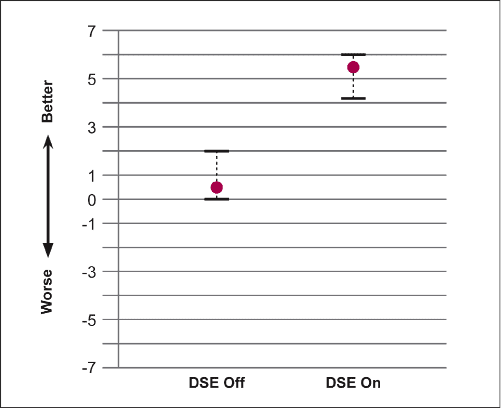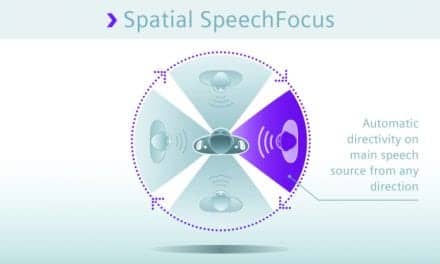A review of old and new strategies for hearing speech in noise
By Patricia Ramirez, AuD, Catherine Jons, AuD, and Thomas A. Powers, PhD
A long-standing challenge in the manufacturing and fitting of hearing aids is improving the understanding of speech in background noise. This goal is particularly difficult because cochlear hearing loss reduces the patient’s ability to extract meaningful words when background noise is present. This has been illustrated in research with commonly used speech-in-noise tests. Wilson et al,1 comparing individuals with hearing loss to those with normal hearing, found on average that:
- For the BKB-SIN, the hearing-impaired group needed a 4 dB SNR advantage to perform equal to the normal-hearing group.
- For the QuickSIN, which uses more difficult speech material, an average 8 dB SNR advantage was required.
Because many patients with hearing loss expect performance equivalent to normal hearing when wearing hearing aids, these data remind us that we must not only restore audibility, but also improve aided signal-to-noise ratio (SNR) considerably if this level of speech understanding is to happen—a daunting task. It is not surprising that recent MarkeTrak surveys reveal that while 91% of hearing aid users are satisfied with their hearing aids’ performance for one-to-one conversations, only 68% are satisfied when background noise is present.2
Two primary Methods of noise reduction
Modern hearing aids use two general noise reduction types:
Directional microphones. The first (used in the United States since 1971) is directional technology (known as spatial noise reduction) that is present only for a portion of the area surrounding the hearing aid user. This spatial effect is not strictly noise reduction because the output of speech signals also may be reduced if they fall outside the targeted speech area. For most applications, the patient determines the target speech with his/her head movements.
Digital noise reduction (DNR). Other noise reduction schemes use digital processing to classify incoming signals and then either reduce gain to reduce the annoyance, or use filtering techniques to “clean up” the speech in noise—to reduce noise between words or in inter-syllabic gaps.
Digital noise reduction algorithms
The different digital noise reduction algorithms are steered by the signal classification system. Specific algorithms tend to be more efficient for different noise types and different signal-to-noise ratios. Siemens traditionally has used three noise reduction algorithms that work independently, yet simultaneously:
Modulation-based noise reduction is most effective for broadband noise, and can improve listening comfort. Its effect is most beneficial when noise is the dominant signal (eg, the low frequencies) where gain can be reduced in specific channels, lessening annoyance. Research also has shown potential for improving speech understanding.3
Wiener (spectral) filtering reduces broadband stationary noise, but because it is fast acting, it also has the potential to reduce noise within the speech signal. For speech understanding, it is usually most effective with somewhat positive SNRs. Research by Ricketts and Hornsby4 has shown that, when Wiener filtering is combined with modulation-based DNR, this processing is preferred for speech-in-noise listening. Other research has shown that this DNR combination also improves the acceptance level of background noise.5
Transient noise reduction dampens peaks in the incoming signal that may be harsh and detrimental to speech understanding. Research has shown that this algorithm improves listening preference for impulse sounds,6 and significantly improves speech understanding in background noise.7
Directional technology (spatial noise reduction)
Directional technology advancements have continued over the past four decades. Modern hearing aids use two omni-directional microphones that allow adaptive polar patterns with automatic steering from the signal classification system (often referred to as beamforming). In 2010, Siemens added anti-cardioid polar pattern capabilities (SpeechFocus) to enhance communication in background noise when someone is talking from behind the listener (see Mueller et al8 for a review). Considerable research with the Siemens directional systems, such as that by Ricketts et al9 and Bentler et al,10 has shown substantial improvement for understanding speech in noise, including real-world settings with a diffuse noise field.
Typically, patients are faced with three different noise types that impact speech understanding:
- Interfering speech is noise created by one or two or sometimes group talkers. It can be quite speech-like, but it is not the speech target signal. With multiple talkers, it becomes babble, and is often referred to as the “cocktail party effect.”
- Stationary noises are where the signal varies much slower than speech in temporal and spectral properties. Examples include the buzz of a crowded street or traffic noise.
- Transient noises change temporal and spectral properties much faster than speech. Examples include clinking dishes or glasses.
Noise reduction algorithms are available to address each of these three noise types, yet many patients remain unsatisfied with hearing aid performance. How can we make things better?
Beamforming and noise reduction: Merging signal processing
In the past, beamforming and noise reduction usually were considered separate units in hearing instrument signal processing. Directional speech enhancement (DSE) noise reduction beneficially integrates both techniques creating a comprehensive noise reduction system that addresses all three noise types: transient, stationary, and interfering speech.
In previous technology, beamforming was complemented with noise reduction algorithms that allowed for improved listening comfort and perceived signal enhancement. Transient and stationary noise reduction algorithms are based on modulation analysis where the temporal spectrum of the signal envelope is used to decide which parts of the signal are noise and which are the target signals.
Modulation analysis, however, cannot distinguish between the speech the wearer wants to hear versus speech regarded as noise. The simple solution is to change the criterion that separates a signal into the target and noise parts. Instead of modulation properties, direction of arrival (DOA) is used—as employed in Siemens micon™.
Using well-established cardioid and anti-cardioid characteristics, the beamforming stage becomes an integrated part of the noise reduction system. This addresses a wide array of disturbing and unwanted noises, while keeping the frontal target speech signal clear and understandable. The noise reduction algorithms share the knowledge of the beamformer, which allows for appropriate enhancement.
Most noise reduction applications include spatial and stationary approaches using a filter rule based on applying a frequency-dependent attenuation to the input signal according to an estimated, frequency-dependent SNR. Applying this formula, the residual noise (after applying noise reduction) may fluctuate because estimating the SNR is never perfect.
Stationary noise reduction commonly provides up to 6 to 12 dB attenuation, but spatial noise reduction may need to temporarily apply more than 20 dB attenuation to effectively suppress loud interfering speech from the back. Integrating stationary and directional noise reduction keeps the 6 to 12 dB limitation for stationary noise to provide a pleasant, stable sound impression for stationary parts of the signal while extending the allowed attenuation range for non-stationary noises to 20 dB and more. The result is a beneficial overall noise reduction effect that preserves excellent target signal quality.

|
| Figure 1. Illustration of the combinations of different types of noise reduction and beamforming in the design of micon Directional Speech Enhancement. (click to enlarge) |
While there are several integration possibilities, the best performance combines the Wiener filter noise reduction approach, which detects how stationary the input signal is in each frequency channel and then fades between the appropriate noise reduction procedures. Based on this analysis, either the stationary or the spatial noise reduction is applied. This combination allows the selection of the appropriate noise attenuation (see Figure 1):
- When stationary signals are detected, the stationary noise reduction is applied to ensure a pleasant residual noise and ease of listening.
- During activity of non-stationary signal components (eg, interfering talkers from the sides and back), using spatial noise reduction guarantees strong attenuation of spatial interferences.
- The control block can be realized using stationary noise reduction gain. When this value is close to the noise floor, there is a strong indication that only a non-stationary signal is present. This evaluation is performed independently in each frequency channel.
Research Findings
An article by Powers and Beilin11 in the January 2013 edition of HR presented clinical research data collected with Siemens micon from two independent sites, including findings for this new directional speech enhancement algorithm. These speech-recognition-in-noise studies revealed that the DSE algorithm provided substantial improvement for understanding speech in noise—with performance exceeding other leading products.11
In another study that focused on the performance of this new algorithm, participants listened to target speech from the front and competing speech from the back. Using a MUSHRA design, the reference (zero line on Figure 2) was no noise reduction. Ratings were obtained for noise reduction with and without the DSE algorithm activated. The participants rated the suppression of the competing speech on a scale from +7 (better) to -7 (worse). As shown in Figure 2, common stationary noise reduction provided little benefit for this listening condition. A substantial advantage was observed for DSE, however, with a median rating of 5.7. Some participants awarded the maximum 7.0 rating, and 75% of the judgments exceeded 4.0.
In summary, speech understanding in background noise is a continuing problem for patients. The directional speech enhancement algorithm of Siemens micon, which combines the proven benefits of noise reduction and beamforming, is a leap forward in technology that provides improvements in this important area.



|
||
| Patricia Ramirez, AuD, is a senior manager of education and training, Catherine Jons, AuD, is an educational specialist in education and training, and Thomas A. Powers, PhD, is vice president of product management at Siemens Hearing Instruments, Piscataway, NJ. CORRESPONDENCE to HR or Dr Powers at: [email protected] |
References
1. Wilson RH, McArdle RA, Smith SL. An evaluation of the BKB-SIN, HINT, QuickSIN, and WIN materials on listeners with normal hearing and listeners with hearing loss. J Speech Lang Hear Res. 2007;50(4):844-56.
2. Kochkin S. MarkeTrak VIII: Consumer satisfaction with hearing aids is slowly increasing. Hear Jour. 2010;63(1):19-27.
3. Ricketts T, Dhar S. Comparison of performance across three directional hearing aids. J Am Acad Audiol. 1999;10(4):180-9.
4. Ricketts TA, Hornsby BW. Sound quality measures for speech in noise through a commercial hearing aid implementing digital noise reduction. J Am Acad Audiol. 2005;16(5):270-7.
5. Mueller HG, Weber J, Hornsby BWY. The effects of digital noise reduction on the acceptance of background noise. Trends Amplif. 2006;10:83-93.
6. Keidser G, O’Brien A, Latzel M, Convery E. Evaluation of a noise-reduction algorithm that targets non-speech transient sounds. Hear Jour. 2007;60(2):29-39.
7. DiGiovanni J, Davlin E, Nagaraja N. Effects of transient noise reduction algorithms on speech intelligibility and ratings of hearing aid users. Am J Audiol. 2011;20:140-150.
8. Mueller HG, Weber J, Bellanova M. Clinical evaluation of a new hearing aid anti-cardioid directivity pattern. Int J Audiol. 2011;50(4):249-54.
9. Ricketts TA, Hornsby BW, Johnson EE. Adaptive directional benefit in the near field: competing sound angle and level effects. Seminars in Hearing. 2005;26(2):56-69.
10. Bentler R, Palmer C, Mueller HG. Evaluation of a second-order directional microphone hearing aid: I. Speech perception outcomes. J Am Acad Audiol. 2006;17(3):179-89.
11. Powers TA, Beilin J. True advances in hearing aid technology: what are they and where’s the proof? Hearing Review. 2013;20(1):32-39.






